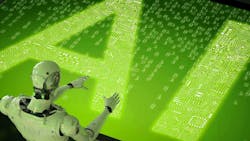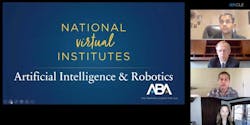Winning the Case: Legal Implications for Advanced Robotics and AI
The American Bar Association Section of Science & Technology Law is presenting the Artificial Intelligence and Robotics National Institute every Wednesday in October. The event is centered around the legal implications of using AI and robotics in many industries. An Oct. 15 session called “You Can’t Make This Stuff Up: AI and Robotics in Manufacturing” dived into legal precedents and insurance considerations for using these technologies in manufacturing facilities.
There are many opportunities for AI and robotics implementation in supply chain management, product design, production, sales and support. Dr. Manish Mehta, technical director of innovation at Stanley Black & Decker, discussed some use cases for Industry 4.0 technology in manufacturing facilities and distribution centers.
“In a connected plant, AI-driven insight generated from quality data in real time helps the quality of the assets throughout the day,” he said. “Insights from controller and sensor data also helps determine major causes of downtime on the motor line.”
Mehta said much of the difficulty in adoption of these technologies is centered around rescaling and retraining the humans that work in close proximity to the advanced systems.
“The role of factory workers is changing,” he noted. “It’s going to be essential to upskill them.”
These microskills workers will have to learn include working alongside a robot, maintaining and troubleshooting the robot, performing data analysis and strategic planning.”
Christopher Lubeck, senior director, head of Patents and Open Source at ServiceNow, explained the history of robotics development. His timeline started with a patent filed by Nikola Tesla in 1898, which would prove to be a bit ahead of his time. Lubeck said that robotics began taking hold in the automotive industry in the 1950s, and much of the resultant societal concern mirrors what we face now: Factory workers were afraid their jobs would be taken over. Robots (then and now) are used for tasks that humans don’t want to do, or tasks that are too dangerous for humans to perform.
“[They] would help cast the vehicles, so you’re dealing with molten metal,” Lubeck said. “So there’s really been a history of robots that would help make things safer.”
Lubeck echoed Mehta in noting that two issues facing robotics development are the lack of dexterity and vision. Robots find it difficult to replicate the motion of human hands, and earlier robots had far less joints compared to robots today. An issue the industry still deals with today—especially in autonomous vehicles and household robots—is the fact that robots receive imaging in 2D, not 3D.
“Manufacturing lines are starting to use some augmented reality,” said Lubeck. “You can actually do detection of defects with augmented reality because the computer will be looking for defects. It can highlight the defects and the trained worker can then interact with the part in a way that is currently still difficult for a robot.”
Thinking of the future, however, still poses many legal questions, especially as these technologies merge and begin working in a more independent capacity.
“As artificial intelligence and robotics expand, there’s going to be more and more liability questions,” said Jeffrey Jones, partner at Jones Day. “The good news is that, on poll, the use of robotics has demonstrated significant safety benefits over time.”
Jones explained that while robotics-related workplace fatalities exist, the ratio is comparatively low to the totality of workplace fatalities across the manufacturing industry.
“You tend to see different views as to how liability issues should be handled,” he said. “Some people advocate that we apply the traditional rules…Others have argued that as we get increasingly complex, there should be new liability rules applied.”
One of the new rules Jones explained would take the form of an insurance-based system—one in which, should an accident be associated with some type of AI or robot, an additional compensation system would come into play. Products liability is an alternative solution to address robotics-related accidents, which would involve a filed claim against a manufacturer. As Jones noted, however, this can become complicated due to the levels of software, code and machines.
“The law tends to have a system in place,” he said. “You can look at component part manufacturers, and you look at those who put it all together.”
The parts manufacturer can show if the parts were up-to-standard and safe when they were sold, much like in Jones v. W+M Automation. That case found the parts manufacturer met its burden and found that the machinery “was safe until GM modified it” after it was installed.
Employer liability is another issue with workplace accidents. While there are compensation systems in place at the state level, employees can contend the accident was egregious and at fault by the employer. Jones cited Miller v. Rubbermaid Inc. , a case in which an employee was allegedly killed by a robot used in plastic injection molding. The court ruled in favor of the employer because there were no noted safety violations, employees received adequate training and a record showed the employee placed himself in danger.
Jones said that the first level of legal protection is ensuring equipment and installation is up to every applicable code. The second is to ensure the AI and/or robotics machinery is running as it should and that there are no malfunctions or dangerous modifications.
“The state of knowledge of the employer will be important,” said Jones. “And there the takeaway is just be cognizant of that. Take steps to address issues as they arise.”
About the Author

Marie Darty
Group Multimedia Director, Engineering & Manufacturing
Marie Darty is a digital media professional currently serving as the group multimedia director for the Manufacturing & Engineering Group at Endeavor Business Media. A graduate of Jacksonville State University, she earned her Bachelor of Arts in digital communication with a concentration in digital journalism in December 2016. In her current role, she leads the strategy and production of multimedia content, overseeing video series planning and editing. Additionally, she oversees podcast production and marketing of multimedia content.

